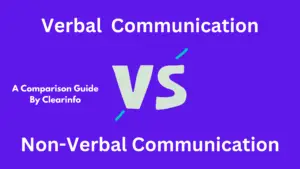In this blog, we will explore the 20 objectives of effective business communication and their importance in achieving success in today’s competitive business environment. So let’s dive in and explore the different objectives of business communication that can help your business thrive.
20 Objectives of Business Communication
Let’s look at how business communication helps an organization thrive and carry out its various functions smoothly. In this section, we will go over 20 objectives of business communication. They are as follows:
1) To receive and provide information: Business communication plays an objective role in the successful operation of any organization, and it plays a critical role in the exchange of information between parties involved in a business transaction.
Effective business communication can be used to both receive and provide information in the following ways:
- Receiving information: Business communication can be used to receive information in various forms such as reports, emails, memos, and presentations. These documents are often used to provide updates on the progress of a project or to share important news and announcements.
- Providing information: Business communication can also be used to provide information to others, such as clients, customers, employees, and stakeholders. This can include marketing materials, product manuals, training materials, and other forms of documentation.
For an organization to thrive and prosper, it is crucial to have information on the following aspects:
1. How consumers respond to its products in comparison to similar products with regard to quality and price, and whether they conform to the latest trends.
2. The effectiveness, suitability, relative advantages, and costs of advertising media along with the latest developments in science and technology.
3. How to procure better quality raw materials on favorable terms or whether there are any more affordable alternatives available.
4. The potential impact of government regulations and changing political conditions on the organization’s product policy.
2) To provide advice: Business communication is often used to provide advice to colleagues, clients, or stakeholders in a variety of ways. Effective advice can help recipients make informed decisions and achieve their goals more efficiently.
When offering advice, it is important for the adviser to keep the following points in mind:
- The advisor should be mindful of the recipient’s understanding and explain things in a way that is easy to comprehend.
- The advisor should use a friendly and respectful tone toward the recipient.
- The advisor should genuinely care about the betterment of the recipient and convey this feeling in their language and tone.
- If the recipient is given the freedom to react, advice can become a two-way channel of communication. This can lead to valuable suggestions for improving the organization’s functioning.
To know more check out the following blog on the art of receiving and giving advice by Havrad Business Review.
-Importance of advice
Advising on business communication is crucial because it helps to foster strong relationships and enhance collaboration between team members, clients, and other stakeholders.
Nature of advice in horizontal and downward Communication
Advice plays an important role in both horizontal and downward communication within organizations. In horizontal communication, advice can be exchanged between peers who share similar roles or responsibilities.
Whereas in downward communication, advice can be provided by managers or supervisors to their subordinates.
3) To provide counseling: Business communication can be a valuable tool for providing counseling to individuals or groups who are facing challenges in the workplace.
Effective counseling requires active listening, empathy, asking questions, providing feedback, developing a plan, and follow-up. The counselor must listen actively and show empathy towards the person or group to build trust and rapport.
Open-ended questions help to identify the root cause of the problem, and honest feedback focuses on the behavior or the situation.
Working with the person or group, the counselor develops a realistic plan of action that addresses the problem and follows up to monitor progress and provide additional support if necessary.
By creating a safe and supportive environment, business communication can help individuals or groups address their problems and work towards finding solutions.
4) To provide orders: Another essential of business communication is that it is used to provide orders or instructions to employees or other stakeholders in an organization. These orders may include tasks to be completed, deadlines to be met, and specific instructions on how to perform a task or procedure.
Different types of orders can be given either in an oral or written format.
Some of the common types include:
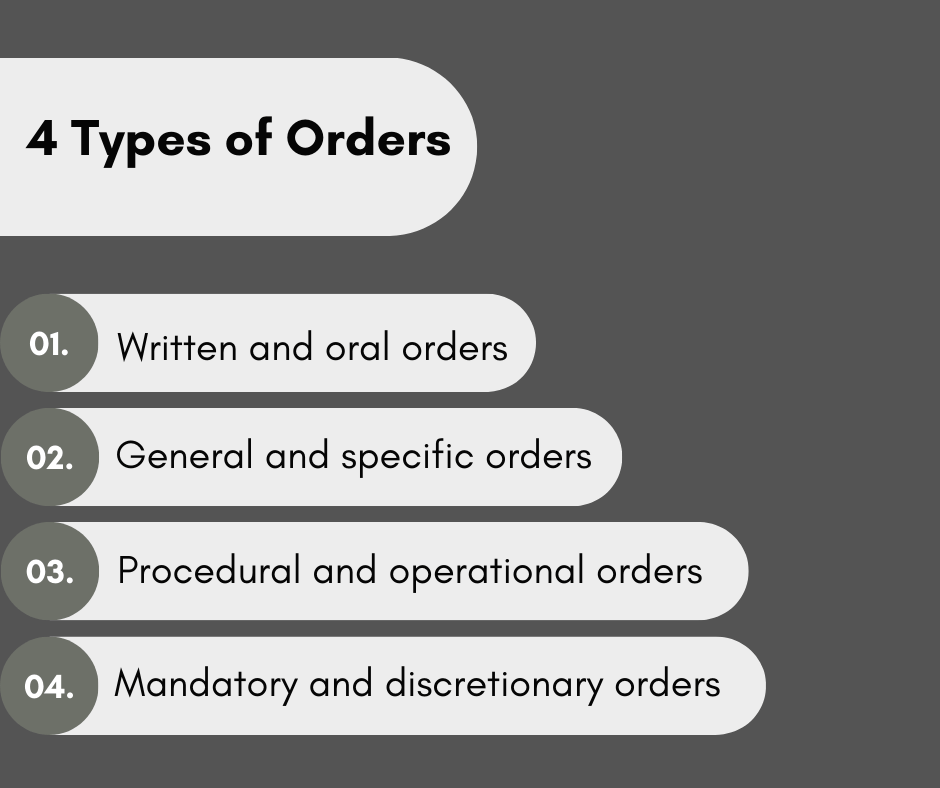
1. Written and oral orders: Written orders are typically provided in the form of memos, emails, letters, or other written documents. They are useful for conveying detailed information.
On the other hand, oral orders are delivered verbally through face-to-face conversations, phone calls, or virtual meetings. They are useful for conveying feedback or coaching in real time.
2. General and specific orders: Orders relating to a broader range of activities that share operational similarities are called general orders. On the other hand, orders relating to one particular activity are known as specific orders.
3. Procedural and operational orders: Procedural orders guide the steps or process that should be followed to complete a specific task or achieve a specific goal, whereas, operational orders are used to guide employees on how to carry out daily operations within an organization.
4. Mandatory and discretionary orders: Mandatory orders are instructions that must be followed. They are often used for important tasks or procedures that require strict adherence to policies or regulations.
Discretionary orders, on the other hand, are instructions that provide employees with a certain amount of flexibility in how to carry out a task or project.
5. To provide instruction: Business communication is often used to provide instructions to employees or team members on how to perform specific tasks or complete certain projects.
Instructions can be communicated through various channels, such as email, memos, training materials, videos, or in-person meetings. The key is to ensure that the instructions are clear, concise, and easily understandable by the intended audience.
Effective instructions can help to ensure that tasks are completed efficiently and accurately, minimizing errors and maximizing productivity.
6) To initiate persuasions: A crucial motive of business communication is that it is often used to initiate persuasion, to convince the recipient to take a certain course of action or adopt a particular viewpoint. Persuasion can be achieved through various communication channels, including email, letters, presentations, or sales pitches.
Effective persuasion requires a clear understanding of the target audience and the specific message being conveyed.
Some key strategies for initiating persuasion through business communication include:
- Analyze the situation: To determine the need for persuasion, you must assess the advantages and disadvantages of the proposed course of action and understand the psychology of the person being persuaded to plan a suitable strategy.
- Prepare the receiver: The next step involves preparing the receiver of the message as people tend to resist being persuaded to change their views or behavior. This can be achieved by putting them in a positive frame of mind, acknowledging their positive qualities and achievements, and appealing to their adaptability and open-mindedness.
- Deliver the message: The third step involves delivering the message in stages. You can use persuasive arguments and present the more agreeable aspects of the message first while delaying the unpleasant parts as much as possible.
- Prompt action: Finally, if the previous steps have been executed properly, the receiver should be inclined to take the desired action.
7) To educate: A key objective of business communication involves using it to educate various audiences, including management, and employees in different ways.
For management, business communication can be used to educate them about new business strategies, market trends, and financial reports.
The communication may be in the form of emails, presentations, memos, or business reports. The purpose of the communication is to provide them with the necessary information and data to make informed decisions.
For employees, business communication can be used to educate them about company policies, procedures, and new training programs. The purpose of communication is to help employees understand their roles, responsibilities, and expectations.
For the outside public, business communication can be used to educate them about the company’s products and services.
8) To give warnings: Business communication can also be used to issue warnings to employees who do not follow the rules and regulations or violate the norms set by the company. Warnings can be issued in various ways depending on the context and the severity of the problem. Here are some common methods:
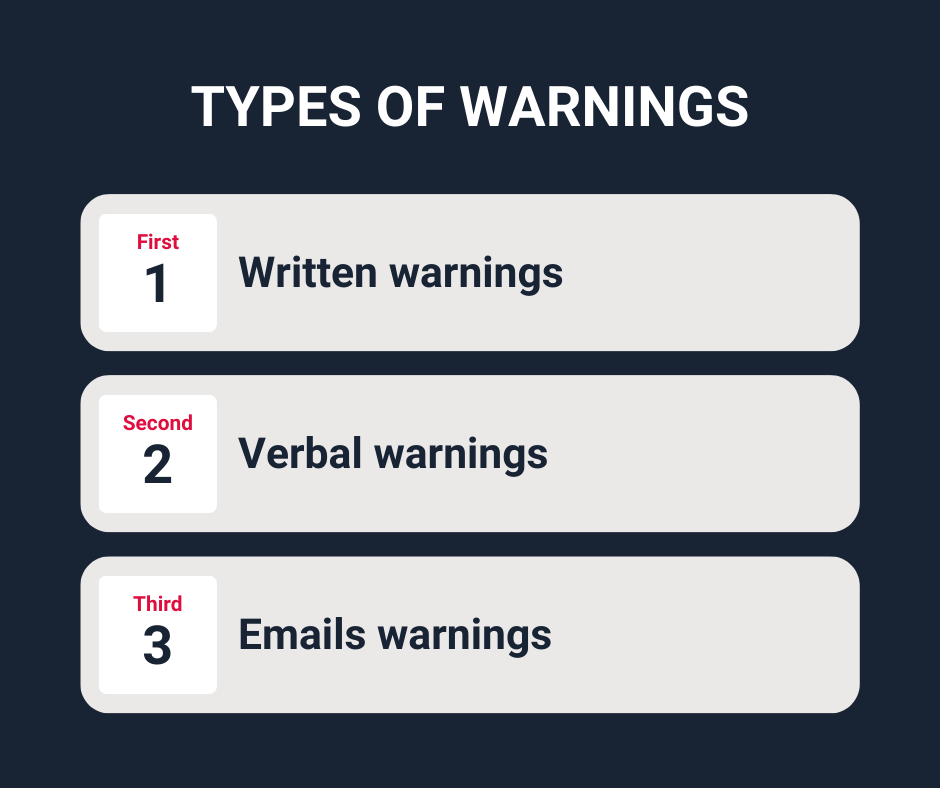
1. Written warnings: This type of warning is issued in a formal written document that communicates an issue or problem with an employee’s behavior or performance.
2. Verbal warnings: Making use of verbal warnings is a less formal way of communicating an issue or problem. They are used to address minor issues or to allow an employee to correct their behavior before a formal written warning is issued.
3. Emails: Managers can also use emails to issue warnings to employees. Emails also create a written record of the warning and can be easily forwarded to others if necessary.
9) To encourage/motivate: Business communication can be used to set clear goals, provide feedback, and offer guidance on how to achieve those goals. It can be used to motivate and encourage employees in the following ways:
- Clarify expectations: One of the most important ways that business communication can encourage and motivate employees is by clarifying expectations. When employees have a clear understanding of what is expected of them, they are more likely to feel motivated and engaged in their work.
- Recognition and feedback: Effective communication also involves providing employees with feedback and recognition for their work.
- Monetary incentives: Encouragement as an objective of business communication can be used to motivate individuals through monetary incentives since their earnings are directly linked to the amount of work they complete.
- Establishing a positive company culture: Effective communication can help establish a positive company culture, which can in turn motivate and encourage employees.
10) To train the workforce: Using business communication to train the workforce can be an effective method of improving employee performance and productivity.
By utilizing different forms of communication, such as written and oral communication, training programs can effectively convey important information and help employees develop the necessary skills.
Written communication, such as emails, memos, and reports, can be used to deliver detailed information about a particular topic or task. This allows employees to review the information at their own pace and refer back to it when needed.
Related Reading: What are the benefits and weaknesses of written communication
On the other hand, oral communication such as face-to-face meetings, video conferencing, and presentations, can be used to deliver information that is more complex or requires interaction between employees.
Related Readings:
Oral Communication: Examples, Importance, Types & Features
11) To utilize resources: Another crucial objective of using business communication is to utilize resources. This can be a strategic way for organizations to optimize their resources and achieve greater efficiency.
Effective communication can help employees identify and share information about available resources, as well as collaborate to develop solutions to utilize them more effectively.
One way to use communication to optimize resources is to create a centralized communication platform. This platform can be used to share information about available resources, such as equipment, materials, or personnel.
Employees can use this platform to request resources they need for their work, as well as to offer resources they have available to share with others. This approach can help to reduce waste, avoid duplication of effort, and enable better resource allocation across the organization.
12) To increase management effectiveness & efficiency: Business communication plays a critical role in increasing management effectiveness and efficiency.
Effective communication between managers and employees can help to establish clear expectations, promote accountability, and foster a positive work environment. Here are some ways in which communication can be used to improve management effectiveness and efficiency:
- Setting clear expectations: Managers can use communication to clarify their expectations for employees, including their job duties, performance goals, and organizational objectives.
- Providing feedback: Effective communication can help managers provide regular feedback to employees on their performance, including both positive reinforcement and constructive criticism.
- Empowering employees: By encouraging open communication from employees, managers can empower their teams to take ownership of their work and contribute their ideas and expertise.
- Building relationships: Effective communication can help managers to build relationships with their employees, promoting trust, respect, and positive work culture.
13) To prepare and execute plans and policies: Planning and carrying out strategies and policies require effective business communication. A plan or policy’s objectives can be more easily attained if important stakeholders are educated, involved, and supportive of them.
Organizations can set clear and attainable targets by clearly articulating the justification for the plan or strategy as well as the precise goals and objectives that are intended to be attained.
By using communication to provide regular updates and progress reports, organizations can ensure that the plan or policy stays on track and remains aligned with organizational objectives.
14) To promote products and services: Business communication can be used to promote products and services. An effective approach is to create compelling messages that focus on the benefits of the product or service.
This can be done through a variety of channels, including email, social media, print or online advertisements, or even in-person presentations or demonstrations.
It is important to tailor your communication to your target audience and use language that they will understand and find engaging. Visual aids, such as images or videos, can also help to grab attention and communicate your message more effectively.
Related Reading: Advantages and disadvantages of visual aids
15) To provide direction: Effective business communication can provide clear direction to individuals or teams, helping to ensure that everyone is aligned with organizational goals and objectives. Here are some tips on how to use business communication to provide direction:
- Set clear expectations: When providing direction, it’s important to set clear expectations regarding goals, timelines, and deliverables.
- Use clear and concise language: It is necessary to be clear and concise in your communication. Try to avoid using technical jargon or language that might be unclear or confusing to the recipient.
- Provide regular feedback: Regular feedback is essential for ensuring that everyone is on track and making progress toward goals. Providing feedback in a timely manner and being specific about what is working well and where improvements can be made.
- Use a variety of communication channels: People have different preferences for how they like to receive information. Consider using a variety of channels, such as email, video conferencing, or in-person meetings, to ensure that everyone has access to the information they need to do their job effectively.
16) To coordinate: Another important objective of business communication is to coordinate activities and ensure that everyone is working together towards a common goal.
This can be achieved by setting clear goals, assigning responsibilities, using collaboration tools, scheduling regular check-ins, using clear and concise language, and providing regular feedback.
While coordinating, managers must use clear and concise language to avoid confusion and ensure that everyone understands what is expected of them.
Using collaboration tools such as project management software and shared calendars can help to keep everyone informed and on the same page.
17) To make effective decisions: Effective business communication is necessary for making informed and effective decisions. To make effective decisions, it is important to gather all relevant information, such as market data, customer feedback, and financial reports.
Once the relevant information has been gathered, it should be analyzed to identify patterns and trends. This analysis should inform decision-making and ensure that decisions are based on accurate and up-to-date data.
It is also important to consider different perspectives and opinions when making decisions, to ensure that all relevant factors are taken into account.
Effective business communication can help to facilitate this process by promoting open communication and collaboration among team members.
By using these tips, business communication can be used to make informed and effective decisions that support organizational goals and objectives.
18) To integrate: Business communication is also used for integrating different teams, departments, or organizations. Here are some tips on how to use business communication to integrate:
- Build relationships: Building strong relationships is key to successful integration. Encourage team members to get to know each other and build trust through regular communication.
- Create a shared vision: Establishing a shared vision for the integrated team, department, or organization.
- Use collaboration tools: Use collaboration tools such as project management software, shared calendars, and online communication platforms to keep everyone informed and on the same page.
- Encourage open communication: Encourage open communication between team members and departments to foster collaboration and a sense of shared ownership.
19) To build strong relationships and enhance the professional image: Building strong relationships and increasing an organization’s professional image both depend on effective business communication.
Managers must be professional and maintain the organization’s professional image by using language that is appropriate for the situation and audience.
Building good relationships and promoting a favorable reputation is an objective of business communication as it can help a company foster a healthy public image and generate quality collaborations.
Understanding the needs and concerns of others requires active listening and prompt response helps in building credibility with stakeholders.
20) To improve discipline: Lastly, a major objective of business communication is that it can be used to boost discipline in several ways. This is done by firstly, clearing communication of workplace policies, guidelines, and expectations can help to establish clear boundaries for employee behavior.
By communicating these expectations, employees will know what is expected of them and what behaviors are unacceptable. This can help to prevent disciplinary issues from arising in the first place.
Goals of Business Communication
The primary goals of business communication are as follows:
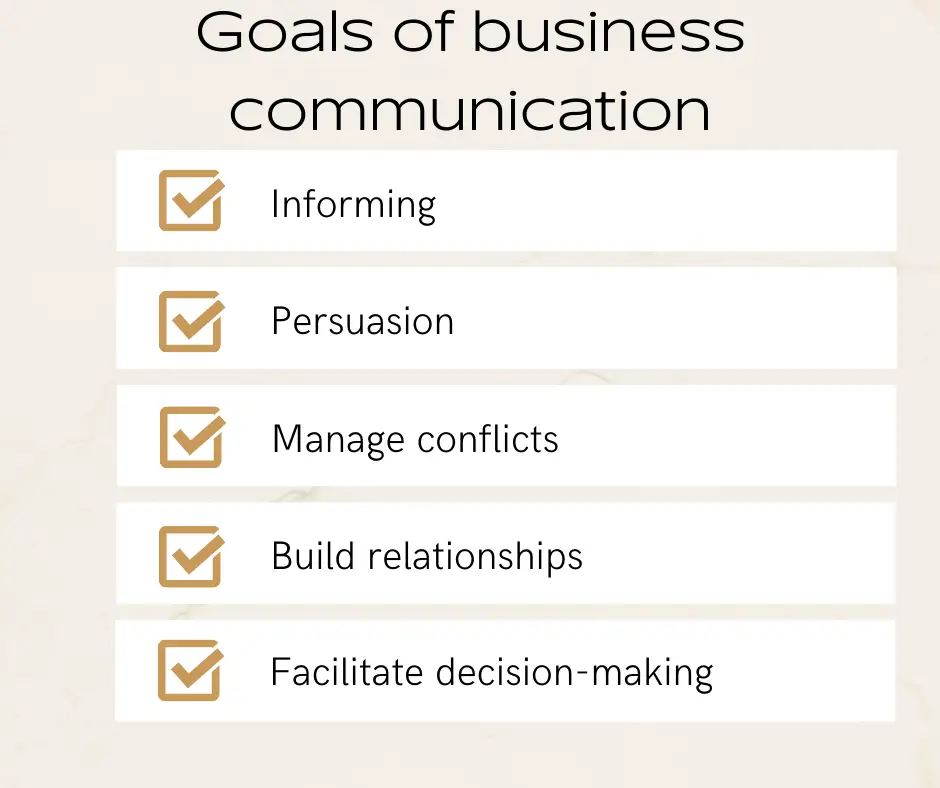
#1. Informing: One of the main goals of business communication is to provide information to stakeholders.
#2. Persuasion: This can include persuading customers to purchase a product, investors to invest in the organization, or employees to adopt a new policy.
#3. Build relationships: The goal of relationship-building communication is to establish trust, mutual understanding, and long-term partnerships with customers, employees, and stakeholders.
#4. Facilitate decision-making: Business communication is used to provide stakeholders and managers with the information they need to make informed decisions.
#5. Manage conflicts: Business communication is also used to manage conflicts, identify issues and provide solutions to problems that arise within the organization or with external stakeholders.
Nature of Business Communication
Business communication is the primary driving force behind all activities undertaken by a company and the people responsible for running it. The prime nature of business communication is the transmission of important information.
Effective business communication skills are crucial in ensuring that this information is communicated clearly and accurately. This includes informing stakeholders, giving advice to trainees and employees, managing conflicts and solving problems, making sales pitches, collaborating and work coordination, and making effective decisions.
Importance of Good Business Communication
Good business communication is essential for the success and sustainability of an organization. Here are some reasons why:
- Improves productivity: Effective communication improves productivity by ensuring that everyone is on the same page and understands their roles and responsibilities.
- Enhances decision-making: By communicating clearly and effectively, stakeholders can make better decisions that are aligned with the organization’s goals.
- Builds relationships: Communication is key to building relationships, and establishing trust and goodwill with customers, suppliers, and other stakeholders.
- Resolves conflict: Good communication can help in managing and resolving the conflicts that may arise in the organization.
- Boosts morale: It boosts employee morale by providing feedback, recognition, and support.
Must Read: To know more check out our detailed guide on 10 importance of business communication in points
Forms of Business Communication
An organization utilizes major 4 forms of business communication. They are:
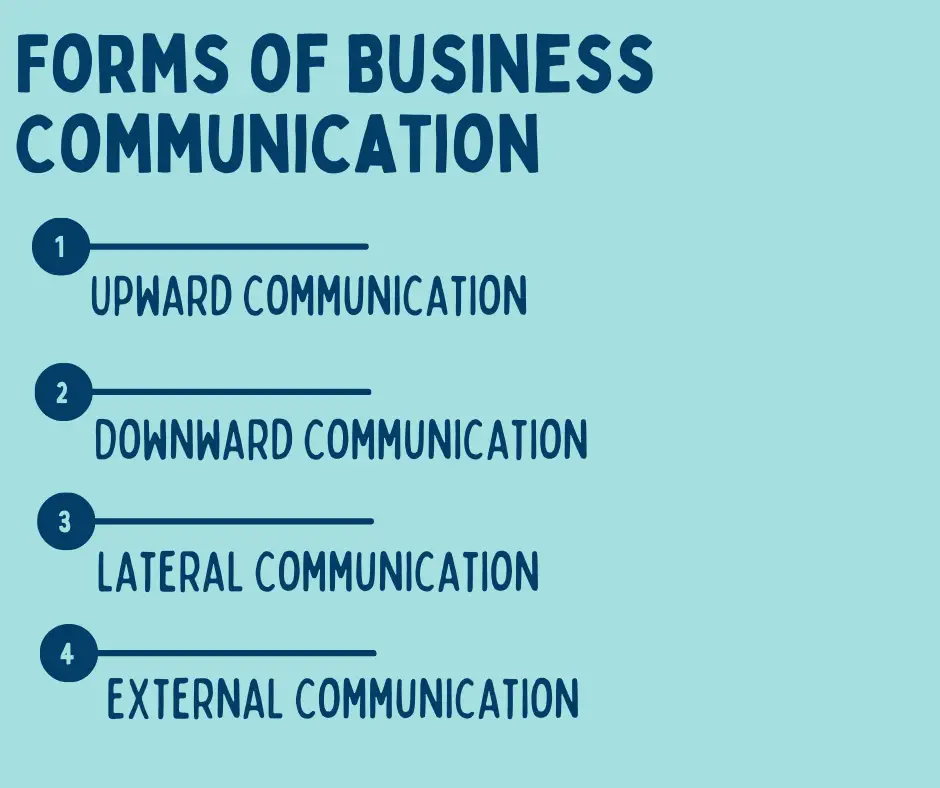
1. Upward Communication: Upward communication refers to a bottom-up form of business communication where subordinates communicate with superiors in the organizational hierarchy.
2. Downward Communication: Downward communication refers to a top-to-bottom type of business communication where the transfer of information is done between managers and supervisors.
Related Reading: What are the differences between downward communication and upward communication?
3. Lateral Communication: Lateral communication or horizontal communication refers to the exchange of information, ideas, and feedback between employees at the same organizational level or in different departments.
4. External Communication: External communication refers to the transfer of information, messages, and ideas between an organization and its stakeholders outside the organization.
Frequently Asked Questions
Q1) What are the objectives of business communication?
Ans: The main objectives of business communication are to convey information, build relationships, and facilitate coordination within an organization.
Q2: What are the principles of business communication?
Ans: The principles of business communication include clarity, completeness, conciseness, correctness, courtesy, coherence, and consistency. Effective communication requires adhering to these principles to ensure that messages are conveyed clearly, accurately, and respectfully.
Q3) What are the objectives of communication?
Ans: The main objectives of communication are to convey information, build relationships, and influence behavior. Communication can also be used to persuade, inform, entertain, educate, and collaborate with others.
Q4) What are the characteristics of business communication?
Ans: The characteristics of business communication include being goal-oriented, concise, precise, audience-oriented, timely, and professional.


